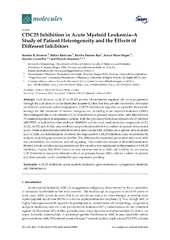| dc.contributor.author | Brenner, Annette | en_US |
| dc.contributor.author | Reikvam, Håkon | en_US |
| dc.contributor.author | Rye, Kristin Paulsen | en_US |
| dc.contributor.author | Hagen, Karen Marie | en_US |
| dc.contributor.author | Lavecchia, Antonio | en_US |
| dc.contributor.author | Bruserud, Øystein | en_US |
| dc.date.accessioned | 2018-09-05T11:53:28Z | |
| dc.date.available | 2018-09-05T11:53:28Z | |
| dc.date.issued | 2017-03-11 | |
| dc.Published | Brenner AK, Reikvam H, Rye K, Hagen KM, Lavecchia A, Bruserud Ø. CDC25 inhibition in acute myeloid leukemia - A study of patient heterogeneity and the effects of different inhibitors. Molecules. 2017;22:446 | eng |
| dc.identifier.issn | 1420-3049 | |
| dc.identifier.uri | https://hdl.handle.net/1956/18404 | |
| dc.description.abstract | Cell division cycle 25 (CDC25) protein phosphatases regulate cell cycle progression through the activation of cyclin-dependent kinases (CDKs), but they are also involved in chromatin modulation and transcriptional regulation. CDC25 inhibition is regarded as a possible therapeutic strategy for the treatment of human malignancies, including acute myeloid leukemia (AML). We investigated the in vitro effects of CDC25 inhibitors on primary human AML cells derived from 79 unselected patients in suspension cultures. Both the previously well-characterized CDC25 inhibitor NSC95397, as well as five other inhibitors (BN82002 and the novel small molecular compounds ALX1, ALX2, ALX3, and ALX4), only exhibited antiproliferative effects for a subset of patients when tested alone. These antiproliferative effects showed associations with differences in genetic abnormalities and/or AML cell differentiation. However, the responders to CDC25 inhibition could be identified by analysis of global gene expression profiles. The differentially expressed genes were associated with the cytoskeleton, microtubules, and cell signaling. The constitutive release of 28 soluble mediators showed a wide variation among patients and this variation was maintained in the presence of CDC25 inhibition. Finally, NSC95397 had no or only minimal effects on AML cell viability. In conclusion, CDC25 inhibition has antiproliferative effects on primary human AML cells for a subset of patients, and these patients can be identified by gene expression profiling. | en_US |
| dc.language.iso | eng | eng |
| dc.publisher | MDPI | eng |
| dc.rights | Attribution CC BY | eng |
| dc.rights.uri | http://creativecommons.org/licenses/by/4.0 | eng |
| dc.subject | CDC25 inhibitors | eng |
| dc.subject | Acute myeloid leukemia | eng |
| dc.subject | Gene expression | eng |
| dc.subject | cytogenetics | eng |
| dc.subject | leukemic cell differentiation | eng |
| dc.title | CDC25 inhibition in acute myeloid leukemia - A study of patient heterogeneity and the effects of different inhibitors | en_US |
| dc.type | Peer reviewed | |
| dc.type | Journal article | |
| dc.date.updated | 2018-03-05T14:23:05Z | |
| dc.description.version | publishedVersion | en_US |
| dc.rights.holder | Copyright 2017 The Author(s) | |
| dc.identifier.doi | https://doi.org/10.3390/molecules22030446 | |
| dc.identifier.cristin | 1455991 | |
| dc.source.journal | Molecules | |

